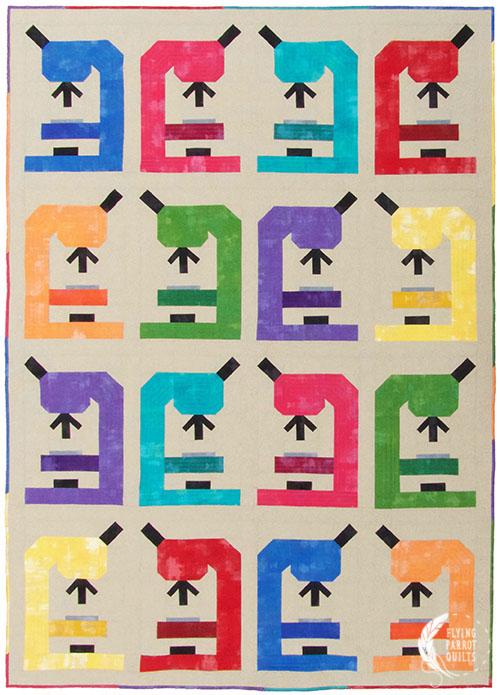In the vibrant intersection of art and science, quilts have long served as more than just textile creations-they are intricate records of human ingenuity, culture, and mathematical precision. The latest feature by Hyperallergic, “Celebrating the Science of Quilts,” delves into this rich tapestry, exploring how quilting embodies complex scientific principles while preserving historical narratives. This article shines a spotlight on the often-overlooked analytical dimensions of quilting, revealing the craft as a dynamic fusion of creativity and calculation that continues to inspire both artists and scientists alike.
Exploring the Intersection of Art and Mathematics in Quilt Design
Quilt design has long been a canvas where geometry and creativity converge, transforming fabric into intricate visual narratives. The patterns within quilts often reflect mathematical principles such as symmetry, tessellation, and fractals, rendering them as much a study in precision as in artistic expression. Artists and mathematicians alike find common ground in these stitched compositions, where angles and shapes not only dictate aesthetic appeal but also reveal complex numerical relationships. The calculated repetition of motifs, for example, can evoke a sense of rhythm much like mathematical sequences, while color gradients follow patterns reminiscent of algorithms that govern natural phenomena.
Examining the elements of quilt blocks unveils a fascinating interplay of design and calculation. Consider the following common shapes and their properties:
| Shape | Mathematical Feature | Quilt Application |
|---|---|---|
| Triangle | Angles sum to 180° | Foundation for star patterns and pinwheels |
| Square | Equal sides and angles | Framing units and checkerboard designs |
| Hexagon | Tessellation without gaps | Traditional flower garden quilts |
- Symmetry: Reflective and rotational symmetries create balance and harmony.
- Proportion: Ratios influence the arrangement and scale of blocks.
- Repetition: Repeating units mimic mathematical sequences and fractal patterns.
Innovative Techniques Transforming Traditional Quilt-Making
Today’s quilt-makers are blending *technology* with tradition, redefining the craft with cutting-edge methodologies that challenge conventional stitching practices. From 3D printing fabrics that mimic classic textures to employing digital embroidery machines capable of rendering intricate patterns with pinpoint precision, the heritage craft is evolving at a rapid pace. Artists and technologists collaborate to produce quilts embedded with sensors and LED lights, transforming these tactile creations into interactive displays that engage audiences beyond mere visual appreciation.
This evolution can be seen in how designers approach both material selection and assembly techniques, propelled by innovations such as AI-driven pattern generation and sustainable bio-fabrication. The following table highlights key techniques currently reshaping quilt-making:
| Technique | Innovation | Impact |
|---|---|---|
| 3D Printed Textiles | Custom filament design | Enhanced texture variety |
| AI Pattern Crafting | Machine learning algorithms | Unique, personalized quilts |
| Smart Fabrics | Embedded sensors & LEDs | Interactive art experiences |
| Bio-fabrication | Sustainable materials from microbes | Eco-friendly production |
- Digitally optimized stitching: drastically reduces production time while increasing detail accuracy.
- Modular quilt design: allows for interchangeable sections, creating dynamic narratives within a single piece.
- Collaborative online platforms: connect quilters worldwide, fostering innovation through shared cultural aesthetics.
Expert Tips for Preserving and Showcasing Scientific Quilts
Maintaining the integrity of scientific quilts requires a balance of careful preservation techniques and innovative display methods. Expert conservators recommend storing quilts in climate-controlled environments to prevent fabric degradation caused by humidity and temperature fluctuations. Avoiding direct sunlight is essential as UV rays can fade vibrant dyes and weaken fibers over time. When handling, use clean cotton gloves to protect delicate textile surfaces from oils and dirt, and always support quilts fully to prevent stress on the seams and stitches.
For showcasing, integrating quilting into museum and gallery settings calls for creative presentation strategies. Consider rotating displays to minimize prolonged light exposure and using UV-filtering acrylic cases for protection without sacrificing visibility. Interactive digital installations can also enhance viewer engagement by revealing the scientific stories woven into each panel. Below is a quick-reference table summarizing preservation priorities and display suggestions:
| Preservation Priority | Recommended Action | Display Tip |
|---|---|---|
| Humidity Control | Maintain 50-55% relative humidity | Use sealed display cases |
| Light Exposure | Avoid direct sunlight; use UV filters | Employ soft, LED lighting |
| Handling | Wear cotton gloves; support fully | Limit handling; use mounts |
| Long-Term Storage | Roll quilts with acid-free tissue | Store in breathable textile boxes |
The Way Forward
As the intricate patterns and storied patches of quilts continue to captivate both historians and art enthusiasts, the celebration of their scientific and cultural significance gains new momentum. “Celebrating the Science of Quilts” not only sheds light on the meticulous craftsmanship behind each piece but also underscores the quilts’ role as living records of history, identity, and innovation. This ongoing dialogue at the intersection of art and science invites us to look closer-beyond the fabric and thread-to appreciate the profound narratives woven into every stitch.
